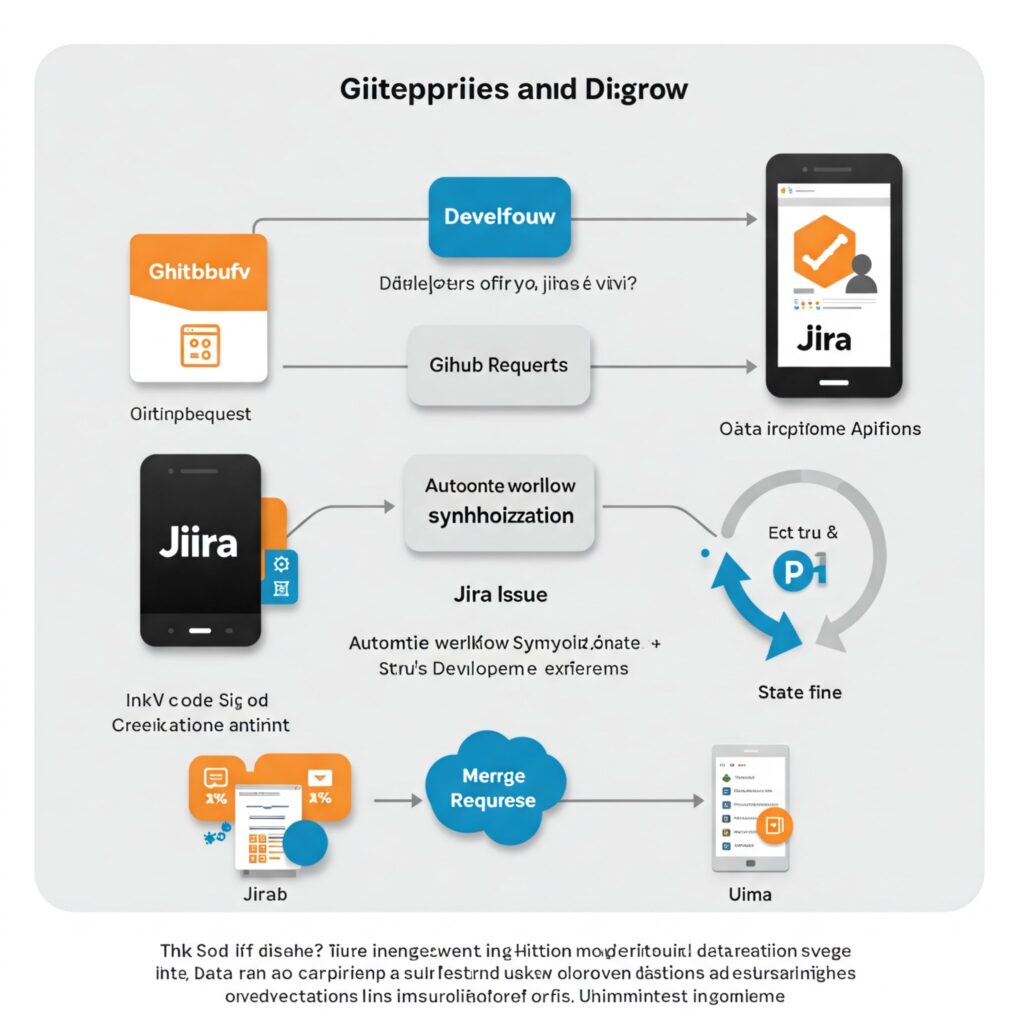In today’s fast-paced software development environment, bridging the gap between source code repositories and project management tools is no longer optional—it’s a necessity. Teams using GitHub Enterprise for source control and Jira for project management often struggle with context switching, siloed workflows, and a lack of real-time updates. To address these challenges, it’s crucial to integrate GitHub Enterprise with Jira. This integration provides a unified ecosystem that enhances collaboration, boosts productivity, and offers deeper visibility into the development lifecycle. This guide explores the full process of how to integrate GitHub Enterprise with Jira, along with best practices and essential tips to make your integration smooth and successful.
Understanding the Core Tools GitHub Enterprise & Jira
What is GitHub Enterprise?
GitHub Enterprise is the enterprise-grade version of GitHub, designed specifically for organizations that need greater control over source code repositories. Whether hosted in the cloud or on-premises, GitHub Enterprise offers advanced security, scalability, and compliance features tailored for large teams. Integrating GitHub Enterprise with Jira creates a seamless flow of data between your repositories and project management tool, allowing teams to efficiently manage tasks. Organizations can take full advantage of the power of integrating GitHub Enterprise with Jira for enhanced collaboration and visibility into project progress.
What is Jira?
Jira, developed by Atlassian, is a robust issue tracking and project management tool widely used in agile and DevOps environments. Jira allows teams to plan sprints, assign tasks, track bugs, and generate reports to monitor productivity. The ability to integrate GitHub Enterprise with Jira enables project managers and developers to stay aligned in real-time, ensuring that every commit and pull request is linked to the correct Jira issue. This connection eliminates manual effort and reduces the chance of miscommunication, making the integration of these tools vital for smooth project execution.
Why Integrate GitHub Enterprise with Jira?
The value of integrating GitHub Enterprise with Jira lies in unifying your tools and removing friction from your development pipeline. By integrating GitHub Enterprise with Jira, teams can automatically link commits, branches, and pull requests with Jira issues. This eliminates the need for developers to manually update Jira tickets, reducing overhead and increasing productivity. The real-time syncing of data also keeps everyone on the same page. Project managers gain visibility into progress, while developers can focus on writing code, knowing their work is automatically reflected in Jira. When you integrate GitHub Enterprise with Jira, you streamline the development process, making it smoother and more efficient.
Pre-Integration Planning and Prerequisites
Confirming Compatibility
Before diving into the integration process, it’s crucial to ensure that both your Jira and GitHub Enterprise environments support the necessary APIs and plugins. Jira Cloud works seamlessly with the GitHub for Jira app available in the Atlassian Marketplace. However, if you are using Jira Data Center, ensure that your version supports third-party app installation and REST API access. For GitHub Enterprise, check that your version is compatible with the GitHub for Jira integration. Compatibility is key to successfully integrating GitHub Enterprise with Jira without any roadblocks.
Setting Roles and Permissions
Security and access control are foundational to a successful integration. Before proceeding to integrate GitHub Enterprise with Jira, assign the correct user roles with appropriate permissions. In Jira, create a dedicated user account with the necessary read/write access to the relevant projects. For GitHub Enterprise, you’ll need a personal access token or OAuth credentials with repo, admin:repo_hook, and read:user scopes. Ensuring the correct permissions is crucial to prevent sync failures and ensure smooth communication between the platforms when you integrate GitHub Enterprise with Jira.
Choosing the Right Integration Method
There are several ways to integrate GitHub Enterprise with Jira, and the best option depends on your organization’s needs. The simplest and most reliable method is using the GitHub for Jira app, available in the Atlassian Marketplace. This app supports both GitHub Enterprise Cloud and Server instances. Alternatively, for teams that require more flexibility, you can manually integrate GitHub Enterprise with Jira using REST APIs. Third-party integration tools, such as Exalate and Unito, offer advanced sync options that can handle more complex workflows. Choose the integration method that best suits your needs before you begin the process of integrating GitHub Enterprise with Jira.
step-by-Step Integration Process
Method 1 Using the GitHub for Jira App

To begin the process of integrating GitHub Enterprise with Jira, start by navigating to the Atlassian Marketplace and installing the GitHub for Jira app. Once the app is installed, authenticate your GitHub Enterprise instance by generating a personal access token. This token will allow Jira to access your GitHub repositories securely. After authentication, map your GitHub repositories to their corresponding Jira projects. This will ensure that every commit, pull request, and branch in GitHub is linked to the correct Jira issue. This simple process allows you to integrate GitHub Enterprise with Jira in minutes and start seeing immediate benefits.
Method 2 Manual Integration Using Webhooks & REST APIs
For teams with more complex workflows, manual integration using webhooks and REST APIs may be necessary. To integrate GitHub Enterprise with Jira using this method, start by setting up webhooks in your GitHub repositories. These webhooks will send updates to Jira whenever code is pushed, merged, or commented on. Then, configure Jira to accept and process these updates through its REST API. By writing automation scripts, you can automatically transition Jira issues, log time, and append comments based on activity in GitHub. While this method requires more setup, it provides ultimate control over your integration when you integrate GitHub Enterprise with Jira.
Common Setup Issues and Troubleshooting Tips
Common issues when you integrate GitHub Enterprise with Jira include authentication failures, webhook misconfigurations, and issues with permissions. If commits aren’t appearing in Jira, verify that the token has the correct scopes and that the webhook is pointing to the correct Jira endpoint. Double-check that the issue keys are correctly formatted in commit messages for smart commits to work. In case of errors, reviewing logs from both GitHub and Jira will help pinpoint the problem and resolve it quickly.
Optimizing Workflows and Post-Integration Best Practices
Enhancing Developer Workflow
One of the major benefits of integrating GitHub Enterprise with Jira is the ability to streamline developer workflows. With smart commits, developers can directly update Jira issues by simply including Jira issue keys in commit messages. For example, by using the syntax ABC-123 #done, developers can automatically transition Jira issues to the “done” state. Furthermore, when a pull request is opened or merged, Jira can automatically update the related issue. This seamless flow allows teams to focus on code while Jira stays up-to-date in real time, ensuring a smooth integration when you integrate GitHub Enterprise with Jira.
Reporting and Traceability
Once you integrate GitHub Enterprise with Jira, teams can take advantage of enhanced reporting and traceability. Jira’s flexible querying language, JQL, allows project managers to create custom filters that surface all issues linked to a specific repository or branch. This gives you clear insights into progress, bottlenecks, and team performance. By creating dashboards, you can monitor the status of issues linked to GitHub pull requests and commits. With this integration, project managers no longer have to manually update status reports—Jira’s real-time updates do all the work once you integrate GitHub Enterprise with Jira.
Ongoing Maintenance and Updates
Maintaining your integration is essential to ensuring continuous, seamless collaboration. Regularly review permissions to ensure that they follow the principle of least privilege. Additionally, monitor the health of the integration by checking logs and sync statuses. As both Jira and GitHub Enterprise evolve, it’s important to keep your integration up to date. Regular updates ensure that you can take advantage of new features and security patches, further optimizing the process when you integrate GitHub Enterprise with Jira.
Conclusion
Incorporating GitHub Enterprise with Jira is a transformative step for development teams looking to streamline workflows and enhance collaboration. By effectively integrating GitHub Enterprise with Jira, teams can eliminate the need for manual updates, reduce overhead, and keep all stakeholders aligned. Whether you choose the simple GitHub for Jira app or a more complex API-based integration, the benefits of real-time syncing between your code repository and project management tool are undeniable. Start integrating GitHub Enterprise with Jira today to improve productivity, enhance traceability, and optimize team collaboration.
FAQs
Can I integrate GitHub Enterprise Server with Jira Cloud?
Yes, you can. Ensure your GitHub Enterprise Server is publicly accessible or set up secure tunneling.
What permissions are needed to set up the integration?
You need admin access to both GitHub repositories and Jira projects, along with a token with specific scopes.
Does GitHub for Jira support smart commits?
Absolutely. Smart commits allow you to transition issues, log time, and add comments via commit messages.
How do I troubleshoot when commits don’t appear in Jira?
Check token scopes, webhook URLs, issue key formats, and user permissions on both platforms.
Are there any limitations to using REST API for integration?
The REST API method requires custom coding and maintenance. Rate limits and authentication handling are common challenges.






